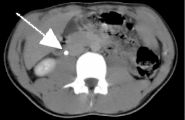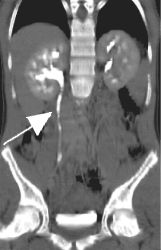 |
ADVANCED IMAGING CENTER PHYSICIAN NEWS |
February 28, 2000 |
HELICAL CT UROGRAPHY: State-of-the-art imaging of urinary calculi
 |
 |
 |
| ||
 |
ADVANCED IMAGING CENTER PHYSICIAN NEWS |
February 28, 2000 |
 |
 |
 |
| ||
Q. Explain helical CT urography.
Helical CT imaging of the urinary tract, when properly performed, allows for rapid detection of urinary calculi, including renal, ureteral, and bladder calculi. Curved reformatted images allow for 4D/multiplanar visualization of the ureters, especially when dilated due to obstruction.
Q. How is the study performed?
At AIC, we obtain 3 helical sets of high-resolution (3 to 5 mm) images through the urinary tract: (1) a precontrast set; (2) an immediate post-contrast set (arterial phase); and (3) a delayed phase, allowing for distinction between ureteral stones and arterial calcifications & phleboliths.
Q. What is the advantage of multi-planar reformation?
This is performed on an Advanced 4D Silicon Graphics Workstation to produce "IVP-like" coronal sections depicting the course of the ureters as shown in the top right image.
Q. What is the accuracy of CT compared to IVP for detection of urinary calculi?
CT is more accurate and much faster than IVP and should be the modality of choice for detection of urinary calculi.
For more information, or for any questions or concerns, please call me personally.
Ray H. Hashemi, M.D., Ph.D.
Director